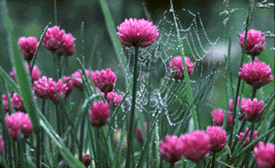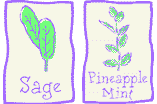
Spice up your inner life!
By bringing your herb garden indoors
By Marion Owen, Fearless Weeder
for PlanTea, Inc. and
Co-author of Chicken Soup for the Gardener's Soul
FEATURE ARTICLE:

Tom Hanks' "Power of Four" solution
More good stuff:
Who is Marion Owen?
FAQs about PlanTea
Search Marion's articles, tips and recipes
Why grow organic?
News and press releases
Read love letters
How to link to this site
Need a speaker?
How to contact Marion
Visiting Alaska?
Come to Kodiak Island!
Go to home page

Marion's UpBeet Gardener
Newsletter has been
replaced by Marion's blog
which you can find at:
www.marionowen.wordpress.com
 For
gardeners who like to cook, there's nothing like fresh herbs. But when the
growing season ends, does it mean you have to resort to grocery
store herbs?
For
gardeners who like to cook, there's nothing like fresh herbs. But when the
growing season ends, does it mean you have to resort to grocery
store herbs?
No ma'am! By bringing a few herbs indoors, you can continue to enjoy a year-round, flavorful bounty.
Here's how to do it:

The best time to pot up most herbs is before the first frost. Start by selecting the healthiest looking plants to bring indoors. Then dig them up--gently now--causing as little root damage as possible. Divide the plants if necessary. Some perennial herbs that make the transition to indoor conditions fairly easily include chives, garlic chives, thyme, mint, winter savory, and lavender.

Chives adapt well to indoor living
conditions
Pot the herbs up in fresh, commercial potting soil and water them well.
Don't skimp on soil quality. Herbs in pots need a reasonably rich soil
mix with good drainage. Here's an all-purpose soil recipe for herbs:
and one part peat moss
Surviving the great indoors
 The
indoor environment can be quite a shock to plants that are accustomed
to cool nights, breezes, rain, and direct sunlight. To help with the transition,
you need to reverse the "hardening off" process. Begin by setting the
plants out of direct sun for about a week. This gets them used to the
lower light conditions indoors. After a few days, bring the plants inside
for a few hours, then return them outside. Repeat this "in and out" routine
for 5 to 7 days, then bring them indoors for good. Believe me, this will
make a big difference in how well the survive the great indoors.
The
indoor environment can be quite a shock to plants that are accustomed
to cool nights, breezes, rain, and direct sunlight. To help with the transition,
you need to reverse the "hardening off" process. Begin by setting the
plants out of direct sun for about a week. This gets them used to the
lower light conditions indoors. After a few days, bring the plants inside
for a few hours, then return them outside. Repeat this "in and out" routine
for 5 to 7 days, then bring them indoors for good. Believe me, this will
make a big difference in how well the survive the great indoors.

Once inside, isolate your herbs (and that means quarantined!) for a couple of weeks before introducing them to the rest of your houseplants. There's nothing worse than causing an infestation caused by overlooking a bug or two.
|
Oh, dear. |
When it comes to light, herbs need at least 6 hours of direct sunlight each day. (Exceptions are parsley, rosemary, thyme, and mint, which can tolerate partial shade). Supplement with flourescent lighting if necessary. A simple, inexpensive shop-light arrangement works just fine. Hang the lights about 6 inches above the plants and give them 14 to 16 hours of light each day. Turn the plants, especially if they're on the windowsill, so they enjoy even lighting conditions.

Herbs need 14 to 16 hours of light per day
A few more tips: Mist plants occasionally, provide good air circulation, and don't crowd the pots together. Herbs are extremely sensitive to dry, stagnant air. Stale air sets up the perfect conditions for pests and fungal diseases. Try to keep your herbs happy with fresh air by cracking a window, setting up a small fan, or by opening doors for good ventilation. If your herb plants become dusty or dirty, you might find my house plant cleaning tips helpful.
Growing herbs indoors also presents a wonderful opportunity to start new plants from cuttings. They make great gifts, plus you'll have a crop of seedlings ready to transplant in the spring. (To start your own herb plants from seed, visit my seed starting tips).
Fertilizing indoor herbs is a little bit of a balancing act. On one hand you want your herbs to be healthy and productive, but not so leggy that they lose their flavor and scent. Feed them monthly with an organic plant food such as PlanTea.
When it comes to watering, herbs can be a little finicky. As a general rule, water most herbs thoroughly when the soil surface starts drying out. Here are some other helpful guidelines:+ Use room temperature -- not shocking cold -- water.
+ Let marjoram, oregano, sage, bay, and thyme dry out between waterings.
+ Don't let rosemary completely dry out.
+ Lemon balm, mint, and scented geraniums enjoy moister conditions.
Herbs work hard as houseplants. They add a certain charm to the indoor environment, giving you flavor, fragrance, and sometimes flowers. With a little extra space, you'll never have to be without fresh herbs again.
Isn't that a wonderful thought? Cheers,
![]()
PSST! For more indoor and outdoor gardening tips, click here.
Thanks for visiting and please stop by again. I'll put the coffee on!
Meet Marion Owen /// Learn about PlanTea /// Online Catalog /// Articles, Tips, Recipes /// Get free UpBeet Gardener newsletter /// Read current issue /// Listen to radio show /// Read news and press releases /// More resources and links /// Learn why 'grow organic?' /// View guidelines for retailers /// Read love letters /// Book Marion as a speaker /// Site map /// How to link to us /// Contact us /// Go to home page
PlanTea: The organic plant food in tea bags. http://www.plantea.com
Copyright ©1996 to present: PlanTea, Inc. All Rights Reserved. PO Box 1980, Kodiak, AK 99615-1980 USA
Questions or comments? marion@plantea.com Phone: Toll Free: 1-800-253-6331 (US and Canada); 907-486-2500